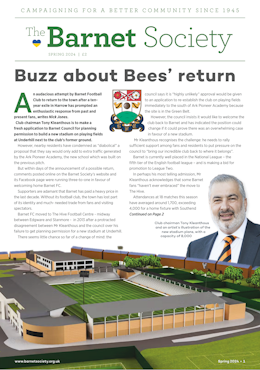This is probably the most significant proposal for Chipping Barnet for many years (unless the High Barnet Station development goes ahead). Although Whalebones is not designated as Green Belt, it includes the last remaining fields near the town centre and is in the Wood Street Conservation Area. The Society considered it sufficiently important to consult as widely as possible among our membership.


Our Committee, President, Vice Presidents and expert advisers were minded to object, but we emailed some 500 members to check whether they agreed or not.
Approximately 10% replied – a fair response rate, taking account of the holiday period. A decisive majority – nearly 90% – objected to the scheme in its present form, and only three members supported it. So we have no alternative but to oppose the application.
We do so with some regret. We accept the principle of some new housing to fund replacement facilities for the artists and beekeepers and future maintenance of the estate, and it is unusual to have building and landscape design of such quality proposed in Chipping Barnet. So why are we opposing it?
We object to the proposals on two basic grounds: first, it is an unacceptable breach of CA policy; and second, in our view it would be overdevelopment of the site. We also have concerns about its sustainability. I’ll expand…
Conservation Area Policy
The Council's Wood Street Conservation Area Character Appraisal Statement says that, 'The Council will seek to ensure that new development within the conservation area seeks to preserve or enhance the special character or appearance of the area…' We believe that this application would do neither.
It also states, ‘The open rural character of the grounds and views in and across the site are highly important aspects of the character of the conservation area and echo the Green Belt and the open country beyond.' But if the project proceeds in its present form, they would be lost.
Historic England agrees that ‘this would present harm [to] the character and appearance of the conservation area.’
As is particularly evident from the top deck of the bus along Wood Street, in addition to offering fine open views across the site north and south, the meadow at the west end is an essential natural and visual buffer between Chipping Barnet and Arkley; without it, they will lose their separate identities forever.


Were the proposed layout to be flipped, with most of the housing at the eastern end of the site and a green corridor/park between the Whalebones and Elmbank, this could be avoided. But the developer does not seem to have considered that or other possible layouts.
We accept that commercial agriculture is no longer viable on the site. But the developer hasn’t explored other land-based activities of a kind likely to have interested the former owner, Gwyneth Cowing.
These include education, training and/or therapy in horticulture, animal husbandry and environmental studies, perhaps in partnership with a local school or college. A city farm for young and old people, including those with special needs, is another possibility in keeping with the spirit of Ms Cowing’s will.
Altogether, approval of this application would create a very bad precedent for other Barnet CAs.
Overdevelopment
We are unconvinced that so many homes are necessary to pay for replacing the studio and upkeep of the rest of the estate. Given the profits to be made on such an attractive site, such a large development needs proper justification.
A serious consequence of the quantity and type of new homes would be some 200 additional cars and 300 cycles (curiously scarce in the visualisations). These would exacerbate what is already heavy congestion at peak times.
This would be particularly problematic in Wellhouse Lane around the bus terminal, where ambulant and semi-ambulant pedestrians and wheelchairs compound the hazards of increasing hospital traffic.
A further consequence would be higher levels of air and noise pollution – especially unfortunate near a hospital.
We also have some concern about potential ground-water problems on this heavy clay site with a spring in the western meadow.
Sustainability
Although the developer promises a net gain in biodiversity, we are not persuaded that the ecological impact of such a large development and extended construction period could be entirely mitigated.
And although we acknowledge that the developer’s environmental standards represent an advance on today’s norms, they fall short of tomorrow’s challenge: we face a climate emergency. New homes need to be zero-carbon, but these will need a carbon-offset payment to achieve that.
Cutting-edge green technology is not (yet) a planning requirement, but in our view development of this exceptional site on the proposed scale could only be justified by adopting exemplary design targets. A more modest and revised scheme, with exemplary environmental technology, would be something Barnet could be proud of.
Conclusion
Since there’s no chance of altering the proposals at this stage, we must oppose them in the hope that the planning committee will reject them and the trustees will have a rethink – preferably in consultation with the Society.
The application can viewed here:
https://publicaccess.barnet.gov.uk/online-applications/applicationDetails.do?activeTab=documents&keyVal=PUS32VJI0GS00
You can still make your own comments; the deadline for public comments has been deferred to Monday 16 September 2019.


